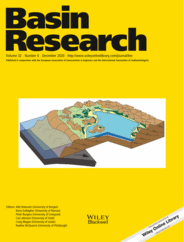
Full text loading...
 , Christopher A.‐L. Jackson1, Howard D. Johnson1, David M. Hodgson2, Harya D. Nugraha1
, Christopher A.‐L. Jackson1, Howard D. Johnson1, David M. Hodgson2, Harya D. Nugraha1
Two types of MTCs (shelf‐edge/upper slope‐derived and diapir‐derived) are identified based on their geometry, volume and source area in a minibasin of the Northern Gulf of Mexico. Shelf‐edge/upper slope‐derived MTCs are relatively large and sourced from the collapse of coeval shelf‐edge deltas, or supplied by reworked upper slope channels and lobes. They are preferentially deposited during the earlier phase of minibasin development. Diapir‐derived MTCs tend to be smaller than shelf‐edge/upper slope‐derived MTCs, they are sourced from the collapse of the salt diapir flanks and deposited during the latest phase of minibasin development.
Mass‐transport complexes (MTCs) dominate the stratigraphic record of many salt‐influenced sedimentary basins. Commonly in such settings, halokinesis is invoked as a primary trigger for MTC emplacement, although the link between specific phases of salt movement, and related minibasin dynamics, remains unclear. Here, we use high‐quality 3D seismic reflection and well data to constrain the composition, geometry and distribution (in time and space) of six MTCs preserved in a salt‐confined, supra‐canopy minibasin in the northern Gulf of Mexico, and to assess how their emplacement relate to regional and local controls. We define three main tectono‐sedimentary phases in the development of the minibasin: (a) initial minibasin subsidence and passive diapirism, during which time deposition was dominated by relatively large‐volume MTCs (c. 25 km3) derived from the shelf‐edge or upper slope; (b) minibasin margin uplift and steepening, during which time small‐volume MTCs (c. 20 km3) derived from the shelf‐edge or upper slope were emplaced; and (c) active diapirism, during which time very small volume MTCs (c. 1 km3) were emplaced, locally derived from the diapir flanks or roofs. We present a generic model that emphasizes the dynamic nature of minibasin evolution, and how MTC emplacement relates to halokinetic sequence development. Although based on a single data‐rich case study, our model may be applicable to other MTC‐rich, salt‐influenced sedimentary basins.
]
Article metrics loading...

Full text loading...
References


Data & Media loading...

